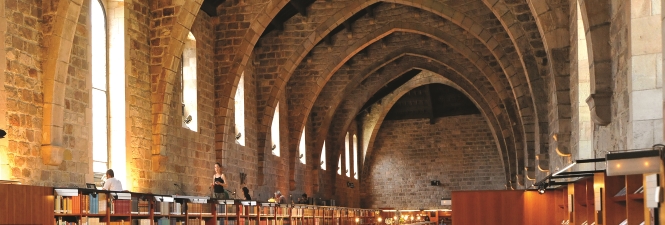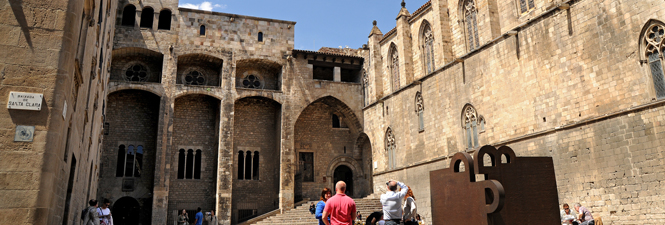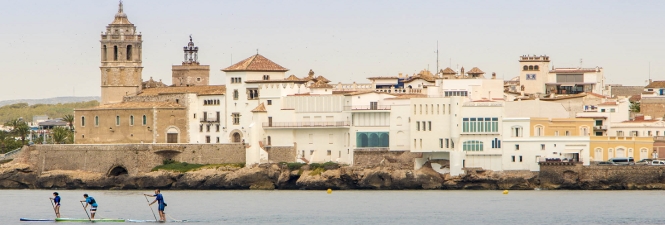

Behind every novel lies a great story. Every book runs the gamut of emotions. Literature fires the imagination. To travel perchance to dream…
We have all been gripped by a story, by a great novel that has had such an impact on us, by a delicate poem… Fortunately books are part of us… and they are part of Barcelona too. The city is home to countless literary locations, novels with the city's streets as their backdrop, with Barcelona-born characters, some of them world famous, like Natalia, the central character of The Time of the Doves, and the protagonists of The Shadow of the Wind.
Now you can relive them all on the following literary trails.
The most famous adventures in world literature
Barcelona forms the backdrop to chapters 61 and 65 of Miguel de Cervantes' Don Quixote of La Mancha, the novel that ushered in the modern era of the genre. The gate known as the Portal de Mar was the most monumental section of Barcelona's ancient walls and opened onto the beach, opposite Maians island. Don Quixote and Sancho Panza enter Barcelona through this gate on Midsummer's Day where they see the sea for the first time and are totally enthralled. Barcelona is, first and foremost, the sea. But it is also the place where Don Quixote is defeated by the Knight of the White Moon, regains his senses, and is cured of his delusions, shortly before he returns home where he dies in bed.
More information about Don Quixote in Barcelona trail

The neighbourhood where the Latin American literature boom was forged
Barcelona is the birthplace of a good number of exiles and an accident of history led it to take in refugee writers. Two of the greatest Spanish-language writers, Gabriel García Márquez and Mario Vargas Llosa, lived and wrote just a short distance from each other. They had both emigrated from the countries of their birth in search of a place to live where they could write in freedom. They became world famous while they were living in Barcelona, under the expert guidance of the literary agent Carmen Balcells. Together they spearheaded the so-called boom in Latin American literature. Similarly, J.V. Foix, who lived in the former village of Sarrià, achieved, through his writings, a mythical reality. His poems evoke, like a dream, memories of rural life before the arrival of electricity.
More information about "The town of Sarrià" trail
The novel by Ruiz Zafón that has captivated millions of readers
You can read any novel, but there are only a few that allow you to truly immerse yourself in and feel part of a story. Carlos Ruiz Zafón's Shadow of the Wind, which has captivated millions of readers around the world, is one such novel. This walking tour will take you to the Barcelona locations featured, from literature to life and from imagination to reality. Just like Daniel Sempere, Julian Carax, Fermín Romero de Torres and the other characters in the novel, we will walk through a labyrinth of mysteries and surprises that becomes a delightful tour, with a fascinating Barcelona backdrop.
The people taking part in the tour will be transformed into the characters, as they make their way through Barcelona to places that can still be recognised by its inhabitants, like Carrer Santa Anna, the Arc del Teatre, the Plaça del Rei, La Rambla, Plaça Sant Felip Neri and Carrer Montcada.

The economic thrust of medieval Barcelona
In the 14th century, Barcelona was a prosperous city that had expanded towards the coast. The new and humble fishing quarter decided to build the biggest church that had ever existed, Santa Maria del Mar, and they used their own money to do so.
A literary trail through the stories and different locations of Ildefonso Falcones' epic novel. Places that, almost 700 years later, can be revisited from a different point of view, while you admire the Gothic Quarter. An opportunity to learn more about the characters and one of the city's most iconic landmarks – the Cathedral of the Sea – which marked the pinnacle of Catalan Gothic architecture.
"From the top of Collserola Mountain, along the Roman road that connected the northern city of Empúries with the southern city of Tarragona, Bernat discovered for the first time the freedom and vastness of the sea".
More information about The shadow of the wind and The Cathedral of the Sea trails
The origins of Catalan art nouveau: modernisme
Situated just 20 miles from Barcelona, the famous seaside town of Sitges was the cradle of Catalonia's home-grown art nouveau: modernisme. Cau Ferrat, the home of Santiago Rusiñol, was the place where this movement was forged. In Sitges, lovers of art and literature and art can visit the main landmarks associated with modernisme, to which present-day Barcelona and Catalonia owe such a debt.
Rusiñol was a true all-rounder – a writer, playwright, journalist, painter and collector – who attracted countless intellectuals and artists to this town in the Garraf, which is also renowned for its beaches. Between them they left us an impressive architectural, literary and aesthetic legacy.
The Museu de Maricel, the Museu Romàntic and the Palau de Maricel are also deserving subjects for writers.
More information about Santiago Rusiñol & Sitges trail
Romanticism in traditional Catalonia
Jacint Verdaguer (1845-1902) is one of the leading literary figures of modern-day Catalonia. A romantic poet, who was part of the generation of the 1874 Restoration, he earned Catalan a place as a literary language during the cultural renaissance known as the Renaixença.
The Verdaguer trail through Vic departs from the tourist information office in the capital of the county of Osona. The first place on the tour is the balcony of city hall, which overlooks the main square, the Plaça del Mercadal. It then continues to different places in the old town that evoke the poet's formative years, his time as a student and life in intellectual circles.
The tour includes a visit to the collection of the Museu Episcopal de Vic and the exterior of the Arxiu Episcopal and the Asil dels Capellans, the priests' residence which evokes the most dramatic period in Verdaguer's life.
More information about Verdaguer & Vic trail

More literary trails in Barcelona:
Neighbourhoods: El Besós i el Maresme. Barbal, Bauçà & Nin.